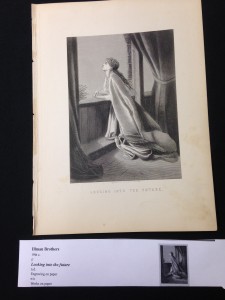For this project, I looked at Joseph Sheridan Le Fanu’s Gothic novella “Carmilla,” originally published in 1871-1872 as a serial in the literary magazine The Dark Blue. Shortly after, Le Fanu republished the piece in his collection of short stories, In a Glass Darkly. In 2014, “Carmilla” was adapted into a modern-day Canadian web series of the same name. As a result, the novella is steadily gaining recognition in popular culture.
The novella tells the story of an eighteen-year-old girl named Laura. As the narrator, she explains that she had been preparing to host a close family friend and his niece for a few weeks. One night, however, Laura’s father receives news from his friend explaining that his niece recently died under mysterious circumstances and he has decided to cancel the trip. Saddened and disappointed, Laura and her father walk out to the drawbridge. While enjoying the moonlight, they watch in horror as a passing carriage falls onto its side. The mother emerges from the carriage unscathed, but her daughter is found to be unconscious. The mother insists that she cannot delay her journey and asks where the nearest village is so that she may leave her daughter there to recover, but Laura implores her father to let the daughter stay with them. He agrees, and they take the young stranger into their home. Laura is instantly drawn to Carmilla, a beautiful and cryptic girl of the same age, and the two become extremely close.
I chose to upload two passages to the VQA. In both passages, Le Fanu expresses the sexual tension between the two girls. Laura develops a passionate love for Carmilla, and although an arguable statement (once Carmilla is revealed to be a vampire, we learn that she tends to seduce and manipulate all of the girls she preys upon), I believe Carmilla falls in love with Laura, too; their deep connection is both physical and mental, as seen in both of the passages I posted. However, regardless of whether their love is requited, the novella is “queer” in the sense that Le Fanu explicitly depicts both girls as lesbians. In the second passage, for instance, Carmilla kisses Laura and tells her that she loves her:
She kissed me silently. … ‘I have been in love with no one, and never shall,’ she whispered, ‘Unless it should be with you.’ … Her soft cheek was glowing against mine. ‘Darling, darling,’ she murmured, ‘I live in you; and you would die for me, I love you so.’
Unlike many other writers from the Victorian Era, Le Fanu doesn’t even code their love for each other; Camilla explicitly states “I love you” to Laura and kisses her, and considering how many Victorians were “prudish,” it’s extremely fascinating that Le Fanu decided to express their love so explicitly, especially in a relationship between two young women. The first passage I chose is even more sensual:
Sometimes after an hour of apathy, my strange and beautiful companion would take my hand and hold it with a fond pressure, renewed again and again; blushing softly, gazing in my face with languid and burning eyes, and breathing so fast that her dress rose and fell with the tumultuous respiration. It was like the ardour of a lover; it embarrassed me; it was hateful and yet overpowering; and with gloating eyes she drew me to her, and her hot lips travelled along my cheek in kisses; and she would whisper, almost in sobs, ‘You are mine, you shall be mine, you and I are one for ever.’ Then she has thrown herself back in her chair, with her small hands over her eyes, leaving me trembling.
Le Fanu’s use of the words “hot lips” sounds like something you might read in an erotic novel in the 21st century, not something from the 19th century! And, again, not only is his word choice unusual for the Victorian Era, but it’s also referring to a relationship between two women. As we discussed in class the other day, I suppose most Victorians couldn’t even imagine two women having anything remotely close to a sexual relationship, so passages like this flew right over their heads.
I would highly recommend reading “Carmilla”–I absolutely loved it! Le Fanu is a brilliant writer.
Link to VQA: http://vqa.dickinson.edu/novel/carmilla
